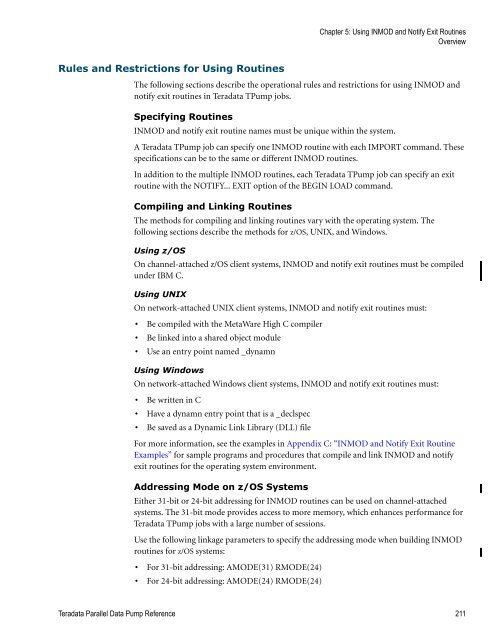Teradata Parallel Data Pump
Teradata Parallel Data Pump Reference - Teradata Developer ...
Teradata Parallel Data Pump Reference - Teradata Developer ...
- No tags were found...
You also want an ePaper? Increase the reach of your titles
YUMPU automatically turns print PDFs into web optimized ePapers that Google loves.
Chapter 5: Using INMOD and Notify Exit Routines<br />
Overview<br />
Rules and Restrictions for Using Routines<br />
The following sections describe the operational rules and restrictions for using INMOD and<br />
notify exit routines in <strong>Teradata</strong> T<strong>Pump</strong> jobs.<br />
Specifying Routines<br />
INMOD and notify exit routine names must be unique within the system.<br />
A <strong>Teradata</strong> T<strong>Pump</strong> job can specify one INMOD routine with each IMPORT command. These<br />
specifications can be to the same or different INMOD routines.<br />
In addition to the multiple INMOD routines, each <strong>Teradata</strong> T<strong>Pump</strong> job can specify an exit<br />
routine with the NOTIFY... EXIT option of the BEGIN LOAD command.<br />
Compiling and Linking Routines<br />
The methods for compiling and linking routines vary with the operating system. The<br />
following sections describe the methods for z/OS, UNIX, and Windows.<br />
Using z/OS<br />
On channel-attached z/OS client systems, INMOD and notify exit routines must be compiled<br />
under IBM C.<br />
Using UNIX<br />
On network-attached UNIX client systems, INMOD and notify exit routines must:<br />
• Be compiled with the MetaWare High C compiler<br />
• Be linked into a shared object module<br />
• Use an entry point named _dynamn<br />
Using Windows<br />
On network-attached Windows client systems, INMOD and notify exit routines must:<br />
• Be written in C<br />
• Have a dynamn entry point that is a _declspec<br />
• Be saved as a Dynamic Link Library (DLL) file<br />
For more information, see the examples in Appendix C: “INMOD and Notify Exit Routine<br />
Examples” for sample programs and procedures that compile and link INMOD and notify<br />
exit routines for the operating system environment.<br />
Addressing Mode on z/OS Systems<br />
Either 31-bit or 24-bit addressing for INMOD routines can be used on channel-attached<br />
systems. The 31-bit mode provides access to more memory, which enhances performance for<br />
<strong>Teradata</strong> T<strong>Pump</strong> jobs with a large number of sessions.<br />
Use the following linkage parameters to specify the addressing mode when building INMOD<br />
routines for z/OS systems:<br />
• For 31-bit addressing: AMODE(31) RMODE(24)<br />
• For 24-bit addressing: AMODE(24) RMODE(24)<br />
<strong>Teradata</strong> <strong>Parallel</strong> <strong>Data</strong> <strong>Pump</strong> Reference 211









